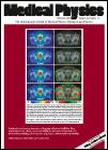版权所有:内蒙古大学图书馆 技术提供:维普资讯• 智图
内蒙古自治区呼和浩特市赛罕区大学西街235号 邮编: 010021

作者机构:Weber State Univ Dept Engn Ogden UT 84408 USA Univ Utah Dept Radiol & Imaging Sci Salt Lake City UT 84108 USA
出 版 物:《MEDICAL PHYSICS》 (医疗物理学)
年 卷 期:2017年第44卷第10期
页 面:e353-e359页
核心收录:
学科分类:1001[医学-基础医学(可授医学、理学学位)] 1009[医学-特种医学] 10[医学]
基 金:NIH [1R01HL108350 U01 EB017185]
主 题:edge-enhancing denoising fast algorithms iterative image reconstruction nonlinear filter x ray CT
摘 要:Purpose: Iterative image reconstruction algorithms are commonly used to optimize an objective function, especially when the objective function is nonquadratic. Generally speaking, the iterative algorithms are computationally inefficient. This paper presents a fast algorithm that has one backprojection and no forward projection. Methods: This paper derives a new method to solve an optimization problem. The nonquadratic constraint, for example, an edge-preserving denoising constraint is implemented as a nonlinear filter. The algorithm is derived based on the POCS (projections onto projections onto convex sets) approach. A windowed FBP (filtered backprojection) algorithm enforces the data fidelity. An iterative procedure, divided into segments, enforces edge-enhancement denoising. Each segment performs nonlinear filtering. Results: The derived iterative algorithm is computationally efficient. It contains only one backprojection and no forward projection. Low-dose CT data are used for algorithm feasibility studies. The nonlinearity is implemented as an edge-enhancing noise-smoothing filter. Conclusions: The patient studies results demonstrate its effectiveness in processing low-dose x ray CT data. This fast algorithm can be used to replace many iterative algorithms. (C) 2017 American Association of Physicists in Medicine